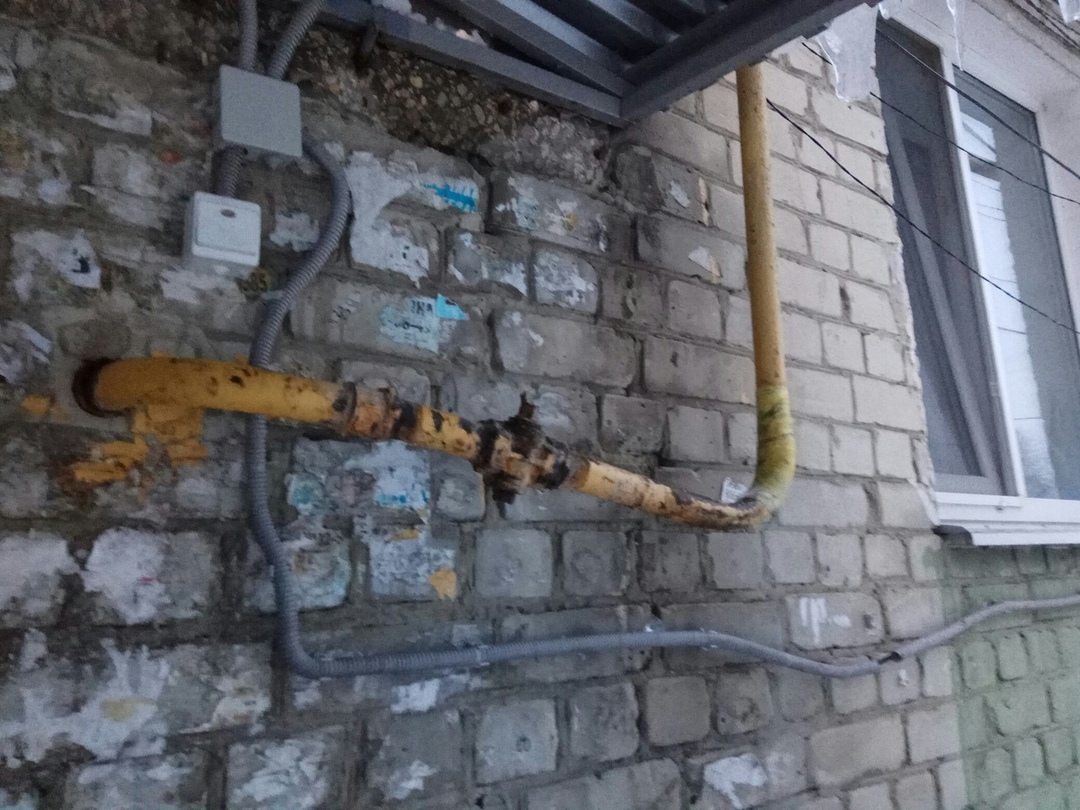Before you buy a gas appliance, you can find out its cost-effectiveness on your calculator. Read about the efficiency of stoves and calculate how much gas a gas stove consumes at standard parameters. Agree, it's better to figure it out one day, and not read articles one after another. Our article will be extremely useful for you.
There is nothing complicated in physical formulas, if you understand the essence of the issue. We will teach you this. Based on the formulas, they determine how much fuel the device uses per hour of active action and how well it works in general. We will reveal the technical side of the issue. At the everyday level, you yourself will decide what to do.
The fuel consumption for the same action for gas stoves varies. Sometimes burners with double power differentials have the same effect. The hobs have burners on the hob, and some models are also equipped with gas ovens. In the article, we have collected information about the power of burners and gas stoves, which you should pay attention to.
The content of the article:
-
Methodology for calculating gas consumption
- How to determine the efficiency of a gas stove?
- Calculation of the calorific value of the fuel used
- Nuances in calculating the volume of gas
- Gas consumption calculation example
- Conclusions and useful video on the topic
Methodology for calculating gas consumption
Consumption is calculated based on the total power of all cooking zones gas stove and its various functions. Counting can be useful when looking for new equipment, because the difference in fuel consumption between two models reaches 2-3 times.

Electric stoves cannot oust gas stoves from the market, and the latter have more and more new opportunities: touch panels, voice control, ignition protection
The power of the burners (burners) is indicated in the passport for the stove, and it will be issued upon request. In order not to solve the problem of excessive gas consumption, products without a passport should be avoided.
Household gas stoves have 2 to 6 burners on the hob and 1-2 in the oven if it also runs on gas. The burners are divided according to their performance into powerful - large, ordinary - medium and burners with reduced productivity - small. The higher the power, the more fuel the burner uses. In the instructions for different stoves, the concepts of power level do not coincide.
Average parameters for burners:
- power of 1 auxiliary (small) burners or the so-called capacity of burners with auxiliary action - up to 0.6-1 kW;
- power 1 semi-fast (medium) burners - approximately 1.1-2.1 kW, sometimes - not less than 1.6 kW;
- power 1 fast (large) burner - approximately 2.1-3.1 kW;
- power of 1 oven burner - more than 3 kW for one and from 2 kW for each, if there are two of them.
The total power used depends on the number of burners lit, the size of the flame and the use of additional options. Typically, it is at least 5.5 kW when all the hob and oven burners are used simultaneously.
Useful features, including oven lighting, take only 15-25 watts. Classic stove has 4 burners and everything is on the hob: 2 normal performance and 1 each high and low.
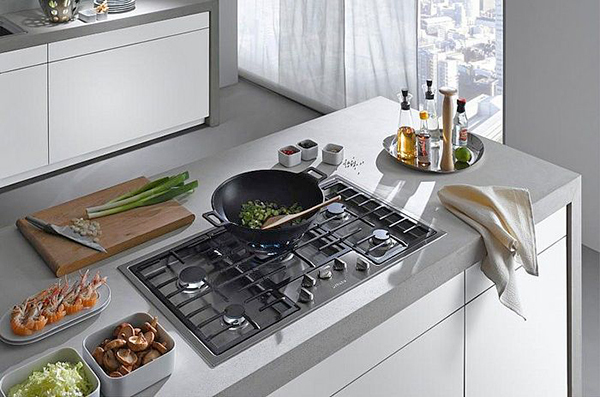
Built-in gas hob: the cost starts at only 3,500 rubles for a 2-burner and 4,500 for a 4-burner, and its models differ significantly in the power of the burners
The maximum gas consumption by the stove is determined by the formula Vhour = Q / (q × efficiency / 100%), where:
- Vh - limiting gas consumption per hour, m³ / hour;
- Q (also referred to as N, P, S) - the sum of the power indicators for each burner, conventionally - the power of the stove, kW;
- Efficiency (efficiency) - coefficient of positive action,%;
- q - calorific value (specific heat of combustion) of fuel, kW · h / m³.
Calculation of the maximum power will not cause difficulties, but it will not be possible to determine the approximate monthly consumption for comparison with the standard or meter indicator. Depending on how much fuel a gas stove consumes and how many kilowatts, for example, an electric kettle gives out, you can compare the cost of heating water.
The power of the burners is determined according to the passport. The calorific value is taken as an average for a particular type of gas that the stove consumes. It will not be possible to calculate the unknown efficiency before buying a stove.
How to determine the efficiency of a gas stove?
It will not be possible to find out the efficiency on an idle gas stove, and as the main one they take an indicator of 45% - in the middle between a minimum of 30 and a limit of 60%. For electrical appliances, the coefficient reaches 70-90%.
The efficiency of a gas stove is expressed as a weighted average of the coefficients for each burner. For individual burners, it is 28, 29, 30, 31%, etc. to just over 60%. Usually, the more powerful the burner, the higher its efficiency, if we talk about the same stove.
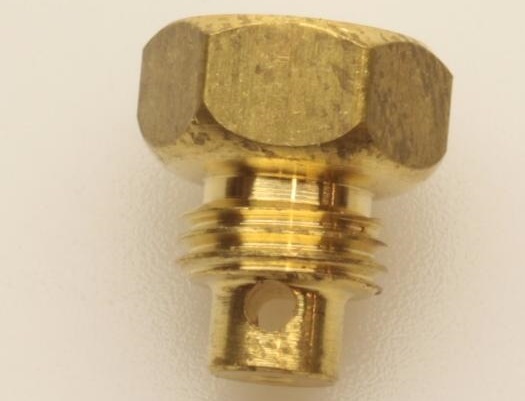
A low-flow screw for the burner tap, which "turns on" when you use the stove in low flame mode - it does not hurt to buy a set of such screws
For comparison, the efficiency of a gas boiler is on average about 90%, but the estimated power would have to be overestimated due to the heat loss of housing. In a room with 2 windows and 2 outer walls - as much as 30%.
The exact efficiency of the slab is calculated by the formula:
ƞ = (Q heating / Q combustion) × 100% = (c × m × ΔT / q × ρ × V) × 100%,
wherein
- ƞ - actually, efficiency,%;
- Q - heat (energy). This value is not needed in the calculation;
- c - specific heat capacity of water, 4183 J / kg · ° C (also 4183 J / kg · K);
- m - mass of water heated in a kettle, kg;
- ΔT - the difference between the boiling point (+100 ° C) and the initial temperature of the water, ° C. Usually it is 73-79 ° C;
- q - calorific value of pipeline gas, usually 33.50 MJ / m³. With a translation of 33,500,000 J / m³;
- ρ - density of pipeline gas, kg / m³. We are talking about a corridor of 0.68-0.85 kg / m³. A value of 0.8 kg / m³ should be taken if any other is unknown;
- V - the volume of gas consumed during the heating of water to boiling, m³. In the calculation, the difference in the readings of the gas meter is used - before and after. If there is no separate flow meter for the stove, then before heating the water, you will have to turn off the rest of the gas appliances.
For the convenience of calculation, the same temperature unit is substituted into the specific heat capacity as in the difference for heating water. Take only ° C or K, and in both cases the value is 4183.
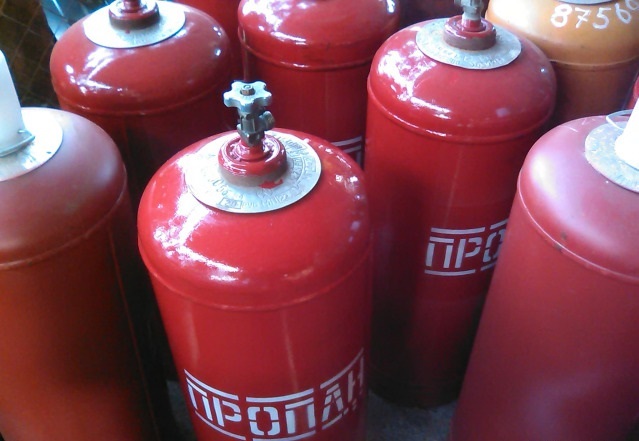
The low efficiency of the stove can be compensated for with a cylinder gas with a higher heating value, but, in addition to the container itself, you will also need a reducer and a hose
For an accurate assessment of the efficiency, the pot for heating the water should be covered with a lid.
Calculation of the calorific value of the fuel used
Distinguish between higher and lower calorific value. The parameters are determined by the highest (Qw) and lowest (Qn) heat (energy) of combustion.
To calculate the actual calorific value, use the formula q = Q / m,
where:
- q - specific heat of combustion (calorific value), MJ / kg (kWh / kg, kcal / kg);
- Q - heat of combustion - the amount of heat released during fuel combustion, MJ (kWh, kcal);
- m - fuel mass, kg.
We substitute Qw or Qn instead of Q and get the highest and lowest calorific value, respectively. The end result is in terms of MJ / kg, kWh / kg and kcal / kg (specific calorie content).
In the case of natural gas, "kg" is replaced by "m³". Knowing the density, you can determine the number of cubic meters per kilogram. For this we take the parameter 0.8 kg / m³. The value in kWh / kg is multiplied by 0.8 and we get the figure in kWh / m³. It should be remembered that 1 MJ = 0.278 kWh = 239 kcal.
The specific heat of combustion of natural gas varies between 8 and 11 kWh / m³. Usually it is 9.2-9.3 kWh / m³ - this value is substituted in the very first formula.
For calculations with the power of burners in kilowatts, the indicated number is taken, and for data with MJ and kcal, the equivalents are used: 33.50 MJ / m³ and 8000 kcal / m³. The values are valid for the supplied methane G20 (natural gas), with a nominal pressure of up to 20 mbar. The calorific value reaches 50 MJ / m³ for conventional methane and 41-49 MJ / m³ for natural gas in the subsoil.
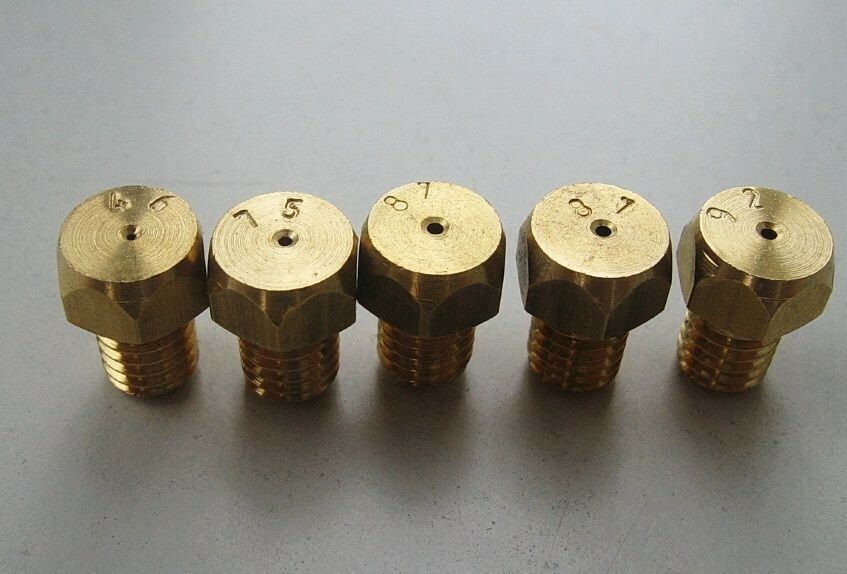
Some stoves can operate at different pressures and types of fuel, for which they buy appropriate nozzles, in the photo - jets for liquefied gas
As the calorific value, they take the indicator of the fuel used - natural gas G20 from the pipeline (mixtures based on methane), but the stoves also work from cylinders. The consumption of liquefied gas in tables is often measured in kilograms rather than cubic meters, but equivalents can be used for calculations.
Liquefied gas is 1.35 in "natural". Methane, propane and ethylene have coefficients 1.494, 1.361 and 1.434 in determining the specific heat of combustion.
Nuances in calculating the volume of gas
The maximum gas consumption per hour shows the consumption of a gas stove with each burner operating at full power for 60 minutes in a row. The stove, which is used by 4 people, consumes on average about 0.5 cubic meters per day.
Usually more than 3 and less than 4 m³ per person are obtained per month. In bills for apartments without gas meters, the indicators on the stove "grow" 3-4 times. This is due to the fact that consumption standards are adjusted to those who use large volumes of gas.
Different maximums of gas consumption have their own standard sizes of meters. The most powerful stoves with an efficiency approaching 30% burn up to 2.5-3 m³ per hour or more during continuous operation at "full speed". For them, it is better to buy a G2.5 meter. For two powerful plates, a G2.5 or G4 gas meter is enough. For small flowmeters G1.6 are suitable.
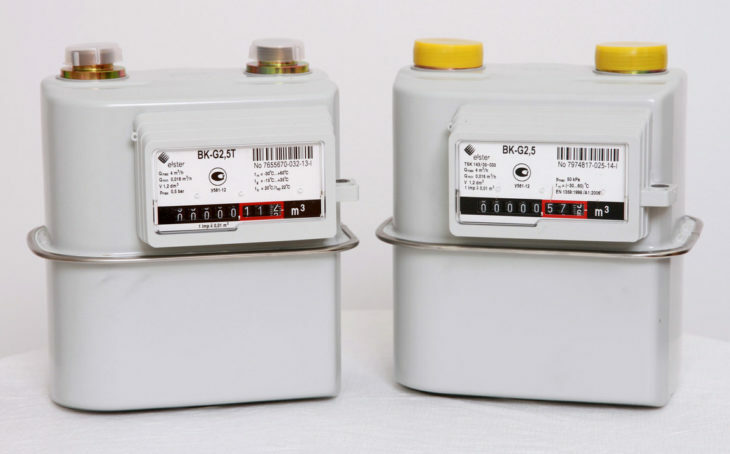
The G2.5 meter is ideal for a large or powerful stove, for a small one, G1.6 is enough, and meters starting from G6 will not be able to "catch" the lower limit of gas consumption by the stove
Household gas meters and their ranges
| Index | Lower and upper limits of the range, flow rate in m³ / hour |
| G1.6 | 0,016 — 2,5 |
| G2.5 | 0,025 — 4 |
| G4 | 0,025 — 6; 0,04 — 6 |
| G6 | 0,06 — 8; 0,06 — 10 |
| G8 | 0,08 — 10 |
| G10 | 0,1 — 16 |
| G16 | 0,16 — 25 |
For the stove and the boiler, it does not hurt to have separate counters. It will be more convenient to navigate and count, and the accuracy of gas meter readings will increase.
Gas consumption calculation example
Consider the consumption of blue fuel by the stove Gefest PG 6500-03 0045. The device has 4 burners on the work surface and a gas oven.
Burner power in kilowatts:
- front right - 3.0;
- front left - 1.75-1.8;
- back right - 1.0;
- back left - 1.75-1.8;
- oven burner - 3.1;
- grill burner - 1.9.
First, we round off the performance of medium-power burners to 1.8 kW. Let's summarize the productivity of all six burners: 3.0 + 1.8 + 1.0 + 1.8 + 3.1 + 1.9. We get 12.6 kW.
We take the efficiency at the level of 45%. We select the specific heat of combustion of domestic gas for two different cases: normal - 9.3 kWh / m³ and maximum - 11 kWh / m³. In the first calculation, we will use the standard one.
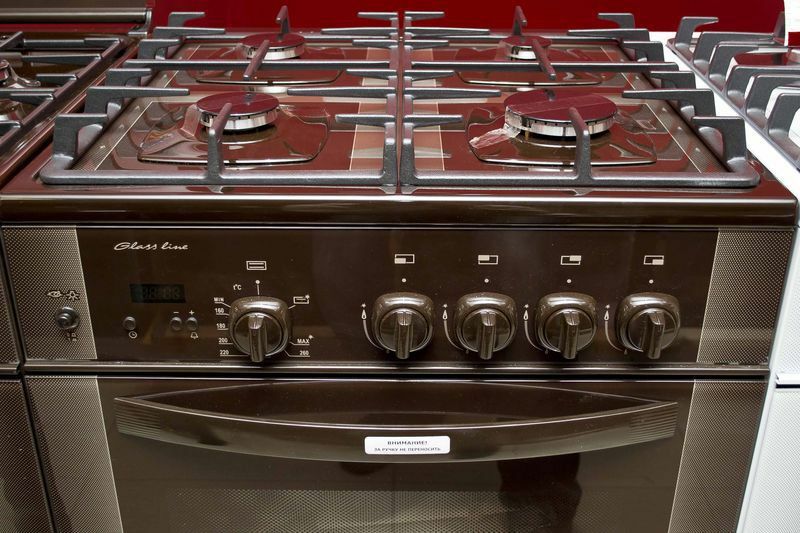
The picture shows a Gefest PG 6500-03 0045 plate, designed for a nominal pressure of 13, 20 and 30 mbar, and with a useful oven volume of 52 liters
We use the formula Q / (q × efficiency / 100%) = Vhour. We get 12.6 kW / (9.3 kWh / m³ × 45% / 100%) = 3.01 m³ / hour.
For complete clarity of the calculation, we will make it in 3 stages: 12.6 kW / (9.3 kWh / m³ × 45% / 100%) = 12.6 m³ / (9.3 hours × 0.45) = 12, 6 m³ / 4.185 hour = 3.01 m³ / hour.
Calculation in steps and only with numbers:
- 12,6 / (9,3 × 45 / 100).
- 12,6 / (9,3 × 0,45).
- 12,6 / 4,185.
- 3,01.
Gefest PG 6500-03 0045 is not the most productive stove, but it has 2 burners in the oven at once, so the maximum flow rate turned out to be so high.
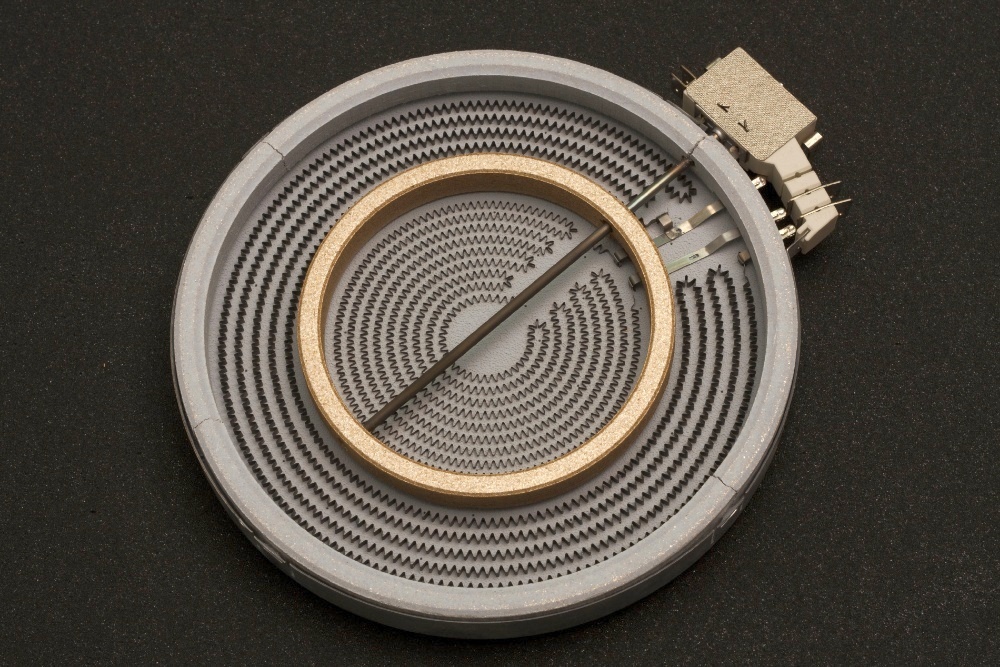
The Hi-Light type burner burner consumes the same as the average burner Gefest PG 6500-03 0045, but heats up in just 5 seconds and has a high efficiency
Let's calculate the fuel consumption with the maximum specific heat of combustion (11 kWh / m³):
12.6 kW / (11 kWh / m³ × 45% / 100%) = 2.55 m³ / hour.
To make calculations, it is enough to have indicators of burner power and know the average values for the rest of the parameters.
As you can see, there is nothing difficult in calculating the gas consumption of the stove. You just need to devote a little time to this.
We also suggest reading our other article, where we talked in detail about how calculate gas consumption for heating at home.
Conclusions and useful video on the topic
An illustrative example of calculating the cost of heating water with devices of different types:
A way to reduce gas consumption and save time on hob cleaning:
The gas consumption and the total power of the burners are directly proportional. If we imagine that the parameters for calculating consumption are equal to the average, it will be enough to know the performance of the burners, and it will become clear how much they save gas.
You cannot do without formula calculations if you know the exact efficiency of the model or are going to determine it. After capacity, this is the second most important metric in terms of costs. Stoves with a hob and a gas oven have higher fuel consumption, but a gas stove can be better in cooking quality than an electric one with high efficiency.
Write comments on the fuel consumption of gas stoves. Tell us if you have measured the gas consumption of the stove. If yes - then write why and what it gave you. The contact form is located below.

